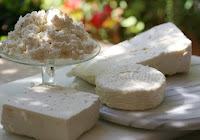Bonamatsi
This dish is the whole Mediterranean in a pot. It’s a classic village dish, homey and healthy. In the original version there is typically no nutmeg and no lemon garnish, but both add depth and balance to the final dish.
For 4 to -6 servings
3 large, firm, ripe tomatoes
2/3 cup northern Greek extra-virgin olive oil, plus more for drizzling
1 large onion, finely chopped
2 garlic cloves, finely chopped
2 fresh bay leaves or 1 dried
8-10 small, preferably new, potatoes
½ kilo (1 lb.) fresh, young spinach, trimmed, washed, spun dry and coarsely chopped
½ cup snipped fresh dill
½ cup snipped fresh fennel
Salt and freshly ground black pepper
Grating of nutmeg
1 lemon, cut into wedges
1.
Trim the base off the tomatoes. Place an upright cheese grater inside a large bowl and grate the tomatoes along the coarse holes until all you are left with is the flattened, circular tomato skin, which is discarded.
2.
Heat 1/3 cup of olive oil in a medium sauce pan and sauté the onions until tender. Add the garlic and stir. Add the grated tomatoes, salt, pepper, and bay leaves. Place in a sauce pan{1. Is that another, additional sauce pan? 2. Also: at which point are the grated tomatoes added?} with the olive oil, salt, pepper and bay leaves. Simmer over low heat, with lid ajarslightly covered, until the tomato mixture is thick, ickened, about 2015 minutes.
3.
Peel the potatoes. Rinse and pat dry. In a large, deep, wide skillet or heavy-bottomed wide, shallow pot, heat the rest of the olive oil and brown the potatoes on all sides until lightly golden and about half cooked.
4.
Add the spinach to potatoes to the tomato sauce and toss in the spinach, in batches, until it loses most of its volume and is wilted. Add the and the herbs. Toss gently to combine. Add the potatoes to the mixture. Toss again, careful not to break up the potatoes. Stir gently with the lid off until wilted. Season with salt, pepper, and nutmeg. Cook until most of the liquid from the spinach has cooked off and the the contents of the pot are thick and the potatoes tender. Serve with lemon wedges if desired.








